A short stopover in the UK to visit friends and family allowed for a brief walk through the ever-changing City. It’s a place familiar to me from my years of studying and working in London. A lot has changed here recently. New buildings are rising towards the sky left and right. Not in living memory has the appearance of this area changed so much in such short time.
How it all began in the 1970s: the NatWest Tower (now Tower 42) was the first skyscraper to be built in the City of London. Hugely controversial back then, it marked the departure from height restrictions previously in place in the area. At 183 meters, the tower was the tallest building in the UK until One Canada Square opened in Canary Wharf in 1990. The photo above shows it from London Wall, with the Deutsche Bank office on the left.
Tower 42 claimed the top spot for the tallest City building until Heron Tower arrived on the scene in 2011 (seen above from New Broad Street). Designed by the starchitect office of Kohn Pedersen Fox, it got a decent review by Guardian critic Rowan Moore, who said that what it showed “is that skyscrapers are not essential emblems of a powerful modern city, but neither are they inevitably destructive blots on the landscape.”
English Heritage fought against Heron Tower claiming that it obstructed views of St. Paul’s Cathedral yet eventually lost the battle. St. Paul’s was again named in connection with a new skyscraper, seen above towering above the Bank of England. The “Cheesegrater”, or 122 Leadenhall Street, derives its name from its unusual triangular shape. One advantage of this is that views of St. Paul’s won’t be as obstructed as they’d be under a normal, rectangular design.
The building will largely be occupied by insurance brokers such as Aon and Amlin, so expect to see more underwriters downing their 5pm pints around the site. The rental market for the new skyscrapers is challenging, according to this Reuters article, with insurance being the better bet in this challenging economic climate.
The Cheesegrater is opposite the design emblem Lloyd’s Building, the youngest-ever building to be Grade I listed. It’s inside-out aesthetics remind the onlooker of the Centre Pompidou in Paris, which Lloyd’s Building (and Cheesegrater) architect Richard Rogers built together with Renzo Piano (who, in turn, left his mark on London with The Shard, see below). Next door is the Gherkin, Norman Forster’s addition to the “icon” category of buildings in the City of London.
No photo tour of today’s City of London would be complete without catching sight of the arguably most controversial addition to the skyline, the Walkie Talkie, or 20 Fenchurch Street. The shape of this building will mean a bigger impact than its size of 160 meters would suggest. Its top heavy form makes the building burst towards the top, taking up much more “space” than what belongs to it based on its footprint.
The closer you get to it from Bank Station, the more you realise how intrusive it is, taking away much of the sky regardless from where you look at it. Part of the reason planning permission was given to the building was that it promises to open a free-for-all three-storey garden on its rooftop. The controversy over the building will likely continue when it opens its doors in 2014.
The Walkie Talkie is perhaps the crassest example of how these new and ambitious skyscraper projects are changing the face and skyline of the City of London. Ex-mayor Ken Livingstone and incumbent Boris Johnson share their desire to further cement London’s global prowess by reaching for the sky. Many agree and say that in order to compete with Dubai, Hong Kong and other emerging megacities, you need to build tall buildings.
I somewhat disagree. While the oddly-named and formed additions of the starchitects make for good PR and high-profile office space for the international finance jetset, they come with a raft of copycats and second-rate developments. This FT article probably gets it right:
(…) the city is carved up between superstars (guaranteed planning permission for big buildings on prominent sites) and corporate plodders (guaranteed maximum plot ratios). The result is a superficial architecture, buildings conceived as developers’ logos. They make no attempt to engage with the complexity of the city, instead wiping its sites clean to create an architecture as bland as any in Shenzhen, Shanghai or Dubai.”
An even more scathing review was written again by The Guardian’s Rowan Moore, who criticises the way planning permission is given almost across the board yet how often promised public elements of the designs are quietly dropped.
I don’t think that European cities need to compete with emerging megacities when it comes to the vertical. There are perhaps better ways to integrate new, modern architecture with the existing historic building stock than to plaster high-rises everywhere. What is perhaps worse than the impact on the skyline (I personally don’t go to Parliament Hill and look towards the City every day) is that these new buildings fail to create any meaningful public spaces.
A tower here and there makes perfect sense, especially along the fringes of the City. Yet before you stack ever more people on top of each other, perhaps it’d be better to spend serious money to upgrade London’s crumbling infrastructure. (Yet my opinion may be slightly biased given my one year of commuting experience on the Greater Anglia line towards Liverpool Street…)
The tour ends with a shot of The Shard, emerging behind the Walkie Talkie, almost in dialogue with its form. The Piano-designed skyscraper is Western Europe’s tallest at 310 meters. Its recently opened observation platform has caused a stir mainly for the astronomical admission prices it charges. Rental occupancy levels have reportedly been low since opening, perhaps reflecting the economic climate as well as the overabundance of floorspace in this segment.
Meanwhile, across the river, another high-profile project, dubbed The Pinnacle, is most probably going to be downscaled in a further sign that the commercial real estate market in the UK’s capital is running out of steam. While London perennially attracts global investors in this segment, even they cannot ignore the possibility of a triple-dip recession.
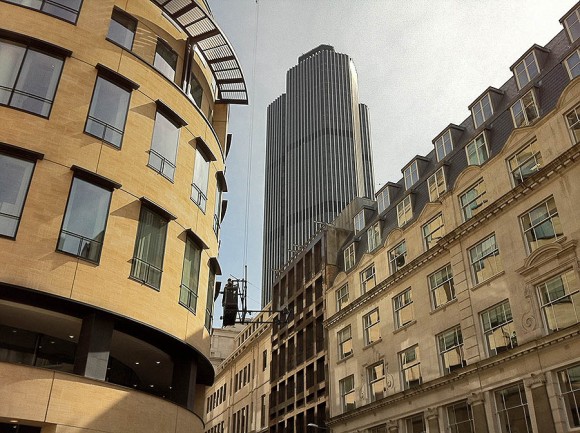

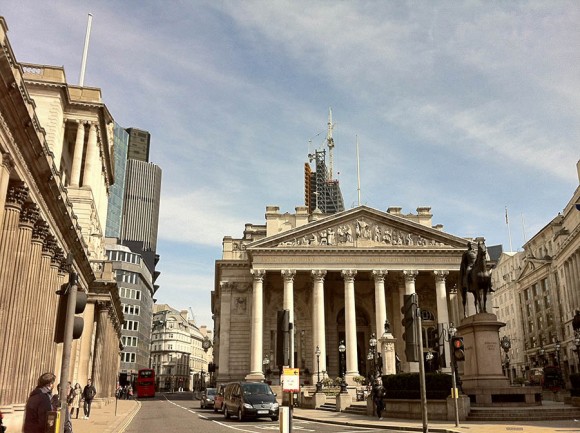



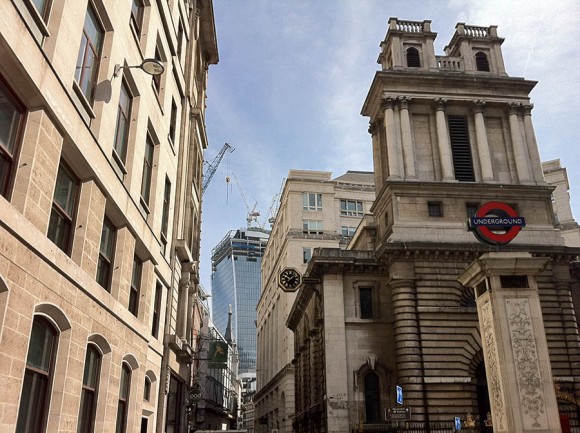
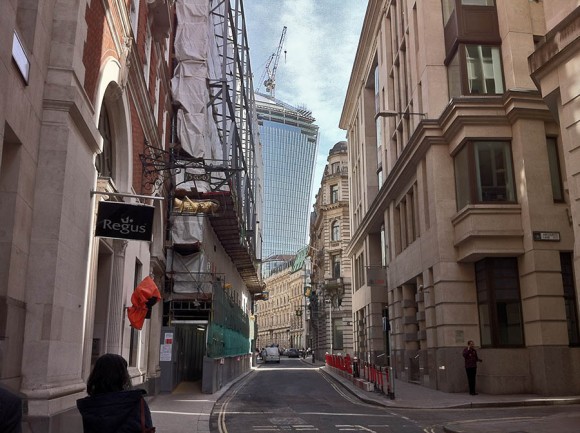

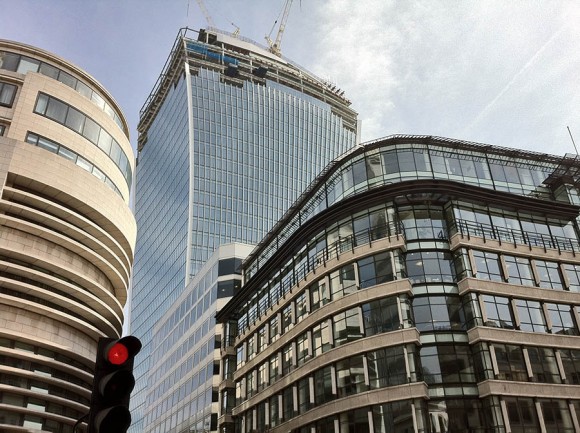
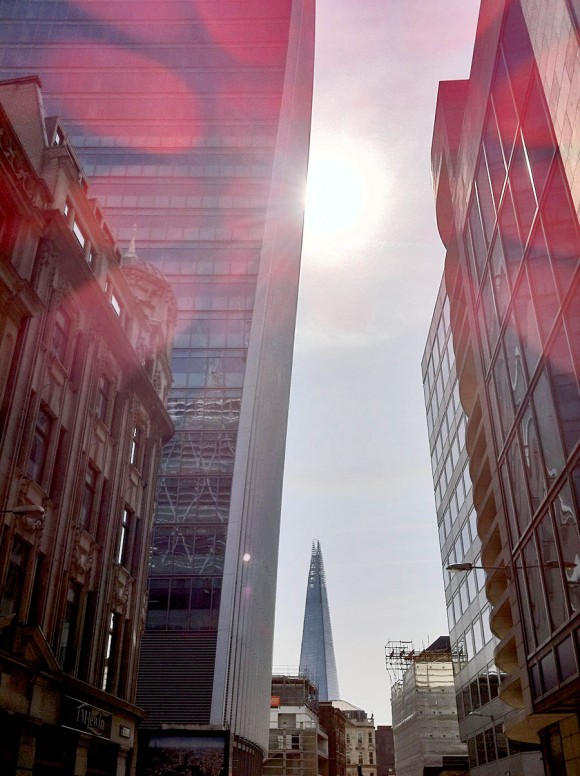

Hi Ben – thanks for this fascinating post. When I briefly returned to London in summer 2012, after a few years in the US, I was similarly struck by the increasing height of the London skyline, in addition to the renovation, demolition and repurposing of old sites, which means that the psychogeography of London as I experienced it during my (like you) university and works years, has been radically shifted. I suppose what it really indicates is that – despite the financial crash of the past 4-5 years – for a many major corporations and financial institutions it continues to be “business as usual”. I can’t help thinking of the proliferation of skyscrapers as a metaphor for the growing disparity between the mega-rich, and the rest of us.
Nick – good to hear from you. You’re absolutely right, it’s strange to see these manifestations of wealth climb the skyline while the UK is mired in recession. Yet the boom seems to be slowing down. I guess a reality check has taken place after all.